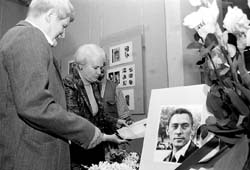On the True Talent of Yury Chekaniuk, discovered only posthumously

Sometimes death is the only way to reveal talent bestowed by nature (or Someone else), for the man that had it lacked the ability of bringing forth his gift. Death tears off the shroud of modesty, exposing the actual picture. Lifetime banal self-presentation becomes more important than the light of talent. This is precisely what happened to Prof. Yury Chekaniuk, Merited Worker of Art of Ukraine, Corresponding Member of the Ukrainian Academy of Architecture. He passed away last year, having almost duped those nearest to him, and all because of his excessive modesty, self-underestimation, or a noble desire to keep in the background, letting others move ahead of him. Whatever it was, another thing is important. With the artist’s death his creative biography only began, as evidenced by the newly discovered works.
Chekaniuk’s paintings are on display at the National Academy of the Fine Arts and Architecture. Their history is very unusual, because no one knew they existed. Chekaniuk’s colleagues say a teachers’ exhibit was held not so long ago, and he failed to submit anything, so everybody thought he had nothing. Even his wife knew nothing about his paintings, for he had kept them secret. Iryna says she found them under the couch. 25 years of creative work and experimenting, all kept secret, except for his book illustrations everybody knew about. Nothing is secret that shall not be made manifest. Chekaniuk’s works of art hidden under the couch were no exception from the rule.
At the opening ceremony much was said about the artist’s drama, an eye-opener on the cruelty of this world, a subtle personality with a soul as finely tuned as Bach’s harpsichord, sophistication. Looking at his works and knowing their story, one must agree. The artist himself believed that architecture was more important, but finally he turned out to be a painter. Incidentally, he designed the capital’s House of Furniture. Prof. Poderviansky noted at the opening ceremony that the constructivism of his paintings was borrowed from architecture, and that his works were filtered. A. Chebykin, L. Skoryk, and D. Chylachava also attended to honor Chekaniuk’s memory.
The key motifs of his works are sacral topics, exotic ornamentation, female faces, and thematic book illustrations. It is hard to discuss anything they share in terms of style, because the themes are so different and require appropriate approaches. Heavy broken lines, like broken destinies in Ukrainian Folklore, sinister Shakespearean overtones, dynamic and fantastic illustrations for Pushkin’s Bronze Horseman, and masterfully simple pictures for Kuprin, Saint-Exupery, Palychka, Fitzgerald, and Drach. Japanese and Indian themes rate a separate story. He never visited the land of the rising Sun, yet created works that are said to have left Japanese viewers enchanted; they did not understand how a man that had never seen Fujiyama could portray it with such striking verisimilitude. Indian nature and scenes from daily life are just as arresting. The exposition includes two self-portraits still to be “deciphered.”






